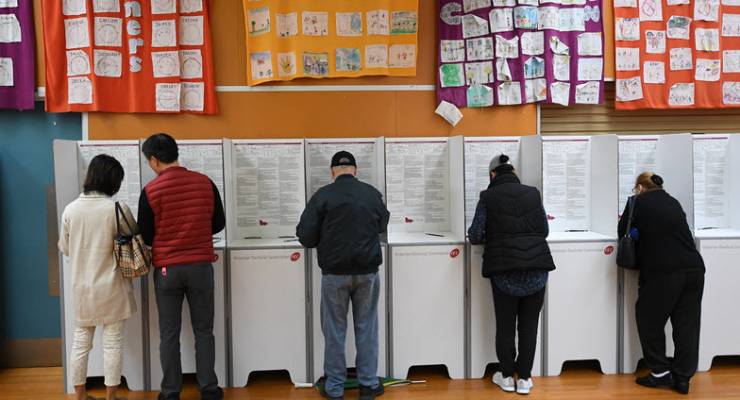
For better or worse, the federal election campaign has been marked by a relative paucity of opinion polling — one of many legacies of the hollowing out of the news media.
However, what they have lacked in quantity, the pollsters have made up for in consistency.
Certainly some have maintained their peculiarities: the Ipsos series for the ex-Fairfax papers continues to report eye-wateringly high support for the Greens and a correspondingly low primary vote for Labor, and there have been variable readings of the balance of support between Pauline Hanson and Clive Palmer.
But on two-party preferred, the ten national polls to have emerged from Newspoll, YouGov Galaxy, Ipsos, Essential Research and Roy Morgan have effectively been of one mind in showing Labor leading either 51-49 or 52-48.
Faced by this picture of unanimity, you may think there are strong grounds for concluding they must each have it more or less right.
But you’d be wrong. For this is not actually how polls are supposed to behave, according to the very story pollsters have to tell about how they work. With the sample sizes that are typical in Australian federal polls — mostly 1000 to 2000 — margins of error come in at between 2.2% to 3%.
If the true picture is indeed somewhere between 51-49 and 52-48, we should certainly expect to see quite a few polls showing exactly that.
But we should expect just as many to land wide of the mark, by one, two or even three points on either side.
As psephological blogger Mark the Ballot points out, the chances of at least a mild outlier failing to emerge reduces to just about zero once you reach the sixth or seventh poll — never mind the ten we actually have seen during the campaign so far, plus a couple of others that preceded it if you want to stretch the point even further.
One possibility is that we are witnessing the natural tendency in us all to seek safety in numbers, which in the polling game is known as herding.
Where a pollster like Ipsos consistently shows the Greens with a 3% to 4% swing since the last election that no one else can see, the temptation to revisit the methodology with a specific view to bashing them back down must be extremely strong — and it’s actually to their credit that they have very clearly resisted it.
However, it’s the two-party preferred numbers that make the headlines, and these look very much to have converged as the election has grown closer and polling has become more frequent.
The million dollar question now is: have they herded to the right place?
It so happens that they appeared to do just that in 2016, when the pollsters were correctly — indeed, excessively — of one mind in calling a tight race that marginally favoured the Coalition.
But there was also pollster unanimity before the Victorian election in November, when four late polls fell 3% or 4% short of correctly predicting the scale a Labor landslide that took nearly everybody by surprise.
If the current pollster consensus proves even half as awry next Saturday, the election will turn out to have been a very different affair from the one we’ve been reading about for the past four weeks.








The polls seem to have been pretty much fixed in place for much longer than 3 or 4 weeks.
It feels as if they’ve been saying the same thing since 2016.
What we don’t know is how many of the undecided voters will reward what has been the worst 2 terms of Government in my memory and how many will vote them out.
My bet, based purely on the increasingly bizarre behaviour of Morrison is that the Liberals are seeing some pretty shocking internal polling data in critical seats.
I think that Labor is in by at least 15 seats. That is not a wish, I have long ago foregone happy thinking. It is a rough estimate based upon actually talking to everybody I meet – strangers mostly. I do this every election. I also engage with LNP voters, who offer some great insights.
I don’t know what Bill Shorten has to do to lose this election, but he better hurry up otherwise in about a week we will have a new PM.
Better him than the tongues talking Ad-man without a clue how to run the economy.
If anyone can lose this election, it is Nill Bortshe.
Raphaella Kathryn Crosby of the Voter Choice Project has reported a 55.1 to 44.9 2 party preferred split in Labor’s favour in her week four survey report from a panel of 1048.
We’ll have to see if Voter Choice Project has credibility. With panel polls if you get it wrong at the start it remains wrong. It’s a difficult thing to do. Since they are well outside the range that the other polls are occupied, if they DO get it right there will be a great deal to crow about. If.
“Where a pollster like Ipsos consistently shows the Greens with a 3% to 4% swing since the last election that no one else can see, the temptation to revisit the methodology with a specific view to bashing them back down must be extremely strong — and it’s actually to their credit that they have very clearly resisted it.”
Doesn’t Ipsos’ overrating of the Greens go back further than “since the last election”? They should resist taking some kind of kludgy method to reduce it, but if they once again prove to be overrating the Green vote when the election result comes around it ought to behoove them to get their sampling right.
To paraphrase Dylan Thomas; if Labor wins the poll or no, I’m sure it will be only touch and go. In Labor’s favour I fervently hope.